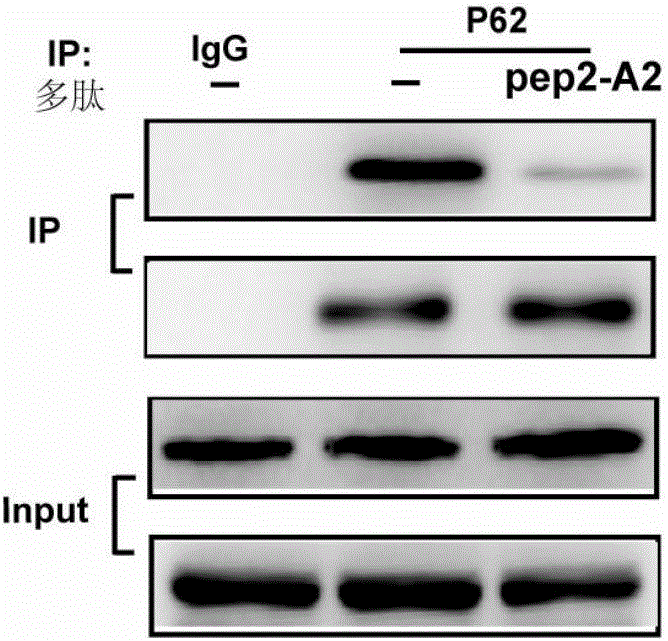Application of polypeptide or its derivative in prevention and/or treatment of hypertensive myocardial hypertrophy
A technology of peptide derivatives and myocardial hypertrophy, applied in the field of medicine, can solve the problems of no kinase activity, lack of ATP binding sites and catalytic residues, etc., and achieve significant curative effect
- Summary
- Abstract
- Description
- Claims
- Application Information
AI Technical Summary
Problems solved by technology
Method used
Image
Examples
Embodiment 1
[0058] Example 1: Screening of peptides binding to TRB3 protein and identification of their biological functions.
[0059] The specific screening method and identification of peptides that bind to TRB3 protein refer to the patent: Peptides that specifically bind to TRB3 protein, its screening method, identification and use (invention title), application number: 201310206907.9. details as follows:
[0060] (1) Use surface plasmon resonance to screen peptides that bind to TRB3 protein.
[0061] First, the P62 protein is truncated into different polypeptide fragments, and the peptides are synthesized with a peptide solid-phase synthesizer. This process is carried out by Beijing Saibaisheng Gene Co., Ltd. EXAMPLES The entire screening process was carried out in a surface plasmon resonance instrument Biacore T200.
[0062] The screening method is as follows:
[0063] (1) The purified protein TRB3 (purchased from R&D Company) was coupled to a CM5 chip (purchased from GE Company) ...
Embodiment 2
[0078] Example 2: Establishment and evaluation of a mouse model of hypertensive cardiac hypertrophy.
[0079] (1) Establishment of mouse model of hypertensive cardiac hypertrophy
[0080] SPF grade ICR mice (male, 7-8 weeks old) were purchased from Beijing Weitong Lihua Experimental Animal Technology Co., Ltd., and were raised in the Experimental Animal Center of the Institute of Materia Medica, Chinese Academy of Medical Sciences, with constant temperature and humidity, and free diet. After the mice were bred adaptively for one week, the ICR mice were anesthetized by intraperitoneal injection of 4% chloral hydrate 10ml / kg, opened the abdomen under sterile conditions, separated the abdominal aorta, and used No. Tighten it together with an injection needle with an outer diameter of 0.6mm, remove the needle quickly, and suture the abdomen layer by layer. The sham operation (sham) group did not perform silk ligation, and other treatments were the same. After 30 days of normal fee...
Embodiment 3
[0120] Example 3: Administration of Pep2-A2 to treat hypertensive cardiac hypertrophy in mice.
[0121] See Example 2 for the establishment and evaluation of the mouse model of hypertensive cardiac hypertrophy. This example is based on the mouse model established in Example 2. After being treated with Pep2-A2, the therapeutic effect is tested.
[0122] (1) Pep2-A2 treatment reduces the mortality rate of mice with hypertensive cardiac hypertrophy.
[0123] The specific operation steps are as follows:
[0124] SPF grade ICR mice (male, 7-8 weeks old) were purchased from Beijing Weitong Lihua Experimental Animal Technology Co., Ltd., and were raised in the Experimental Animal Center of the Institute of Materia Medica, Chinese Academy of Medical Sciences, with constant temperature and humidity, and free diet. After one week of adaptive feeding, the mice were randomly divided into 3 groups according to body weight: 20 mice in the control group, 20 mice in the abdominal aorta ligat...
PUM
 Login to View More
Login to View More Abstract
Description
Claims
Application Information
 Login to View More
Login to View More - R&D
- Intellectual Property
- Life Sciences
- Materials
- Tech Scout
- Unparalleled Data Quality
- Higher Quality Content
- 60% Fewer Hallucinations
Browse by: Latest US Patents, China's latest patents, Technical Efficacy Thesaurus, Application Domain, Technology Topic, Popular Technical Reports.
© 2025 PatSnap. All rights reserved.Legal|Privacy policy|Modern Slavery Act Transparency Statement|Sitemap|About US| Contact US: help@patsnap.com



